1 February, 2002
PUMPING FOR POPS
The POPs team collects water samples for analysis. Two team
members go out in a Zodiac boat to the sampling stations. These are
Stations A (alpha), B (bravo), E (echo), G (golf) and I (India). We use the
names in parentheses when we report our positions back to Palmer via radio.
It is easier to hear the words than the letters when talking on the radio.
These stations are the places established by the Palmer Long Term
Ecological Research Project (LTER), of which our study is a part. The
other LTER scientists are taking measurements (of other things in the water)
at stations B and E, so we do that also. We are taking measurements at
Stations A, G, and I because the wind often comes from the direction
of the glacier. Any POPs from the glacier might be deposited in the waters
around stations G and I.
We use a Global Positioning Satellite (GPS) device to make sure we are at
the proper location on station. If the currents and winds have carried us
away from the sampling site by more than .25 nautical miles, we interrupt
the sampling and move the Zodiac back into position.
We use a battery-operated pump to pump the water. The water intake tube is
lowered by a winch to a depth of 5 meters beneath the surface. We fill up
two canisters of water at each station. Weather permitting, we try to take
water samples from two stations each day. Then we return to Palmer Station,
lift the canisters out of the Zodiac, and take them into the lab. In the
lab, the water is filtered under pressure through an XAD bead resin column.
The columns will be taken back to Virginia for analysis.
Here's the math: Each canister holds 40 liters of water, and each takes
about 25 minutes to fill. What is the flow rate from this pump in
milliliters per minute? How much does the water in each canister weigh?
(one liter of water weighs one kilogram)

Here is the map of the sampling stations around Palmer Station. Station E is right at the 2 mile boating limit.
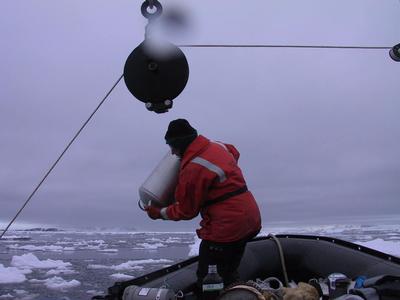
Each canister is rinsed out twice with the sample water before the water is collected in the canister.
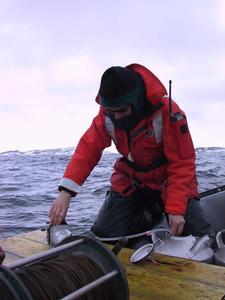
Amy Chiuchiolo is setting up the tube for sampling.

Here is one of the water samples being filtered through the XAD column. The column is the small white tube seen within the stool legs.
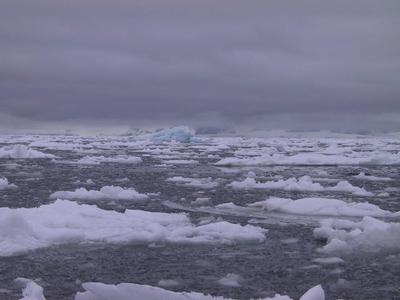
Sometimes we must navigate through sea ice and glacial ice in order to get to a station. This was the view on January 29, 2002.
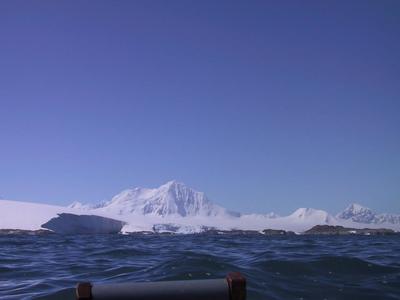
Sometimes the skies are clear when we pump water samples. This was the scene on January 15, 2002. The ocean swells got higher later that day, while we were still out at station E.
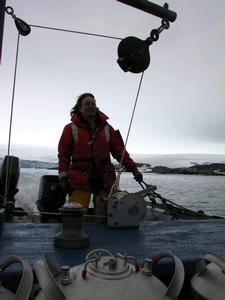
Michele Cochran drives the Zodiac from Palmer out to one of our sampling stations. Notice the winch. We crawl or step on and across the blue platform to get from the bow to the stern of the Zodiac.

Here are the 4 canisters we will fill. Each one holds 40 liters of water. The blue bag is my dry bag. In it I have extra socks, long underwear, hat, and gloves. We are required to take these in case we get wet and need to change. We also keep cameras and food in the dry bags.
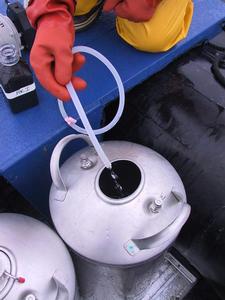
The water flows into the canister from 5 meters below the surface.
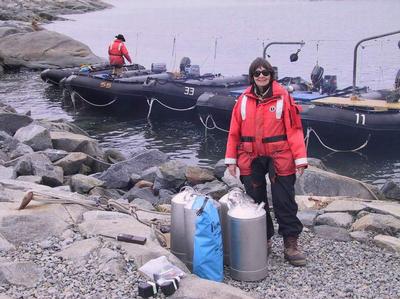
This is how we start out. I am wearing a float coat, with the "beaver tail" strapped from back to front between my legs. You see the canisters and my dry bag.
Contact the TEA in the field at
.
If you cannot connect through your browser, copy the
TEA's e-mail address in the "To:" line of
your favorite e-mail package.
|
